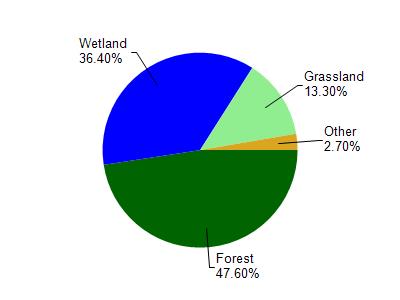Douglas
No
No
No
Fish and Aquatic Life
Overview
This fairly wide, sluggish stream drains extensive tracts of spruce, tamarack, tag alder and willow swamps, resulting in dark-stained, acid water. About two miles north of its headwaters, the creek flows through Bear Lake. Downstream of the lake, the river cuts a wide channel before narrowing to a 10 to 15-foot-wide channel maintained until it empties into the Amnicon River. The river supports a largely seasonal fishery similar to Bear Lake's: including muskellunge, walleye, largemouth bass, yellow perch, bluegill, black crappie, pumpkinseed, white sucker and minnows. Beaver, muskrat, otter, mink and weasel are typical as are nesting and migratory waterfowl.
During survey work conducted as part of the coastal wetlands evaluation, the stream demonstrated moderate taxa richness for macroinvertebrates (5-24 species) (Epstein 1997). The survey noted some turbidity and low flow conditions.
Date 1999
Author Aquatic Biologist
Condition
Wisconsin has over 84,000 miles of streams, 15,000 lakes and milllions of acres of wetlands. Assessing the condition of this vast amount of water is challenging. The state's water monitoring program uses a media-based, cross-program approach to analyze water condition. An updated monitoring strategy (2015-2020) is now available. Compliance with Clean Water Act fishable, swimmable standards are located in the Executive Summary of Water Condition in 2018. See also the 'monitoring and projects' tab.
Reports
Management Goals
Wisconsin's Water Quality Standards provide qualitative and quantitative goals for waters that are protective of Fishable, Swimmable conditions [Learn more]. Waters that do not meet water quality standards are considered impaired and restoration actions are planned and carried out until the water is once again fishable and swimmable
Management goals can include creation or implementation of a Total Maximum Daily Load analysis, a Nine Key Element Plan, or other restoration work, education and outreach and more. If specific recommendations exist for this water, they will be displayed below online.
Monitoring
Monitoring the condition of a river, stream, or lake includes gathering physical, chemical, biological, and habitat data. Comprehensive studies often gather all these parameters in great detail, while lighter assessment events will involve sampling physical, chemical and biological data such as macroinvertebrates. Aquatic macroinvertebrates and fish communities integrate watershed or catchment condition, providing great insight into overall ecosystem health. Chemical and habitat parameters tell researchers more about human induced problems including contaminated runoff, point source dischargers, or habitat issues that foster or limit the potential of aquatic communities to thrive in a given area. Wisconsin's Water Monitoring Strategy was recenty updated.
Grants and Management Projects
| Project Name (Click for Details) | Year Started |
|---|
|
|
Monitoring Projects
| WBIC | Official Waterbody Name | Station ID | Station Name | Earliest Fieldwork Date | Latest Fieldwork Date | View Station | View Data |
|---|
| 2857200 | Bear Creek | 10013115 | Bear Creek- 36 Meters Upstream Tower Fire Lane- Station #1 | 11/1/2005 | 11/1/2005 | Map | Data |
|

Watershed Characteristics
Bear Creek is located in the Amnicon and Middle Rivers watershed which is 288.92 mi². Land use in the watershed is primarily forest (47.60%), wetland (36.40%) and a mix of grassland (13.30%) and other uses (2.70%). This watershed has 641.39 stream miles, 7,914.74 lake acres and 42,306.80 wetland acres.
Nonpoint Source Characteristics
This watershed is ranked Not Ranked for runoff impacts on streams, Not Available for runoff impacts on lakes and Low for runoff impacts on groundwater and therefore has an overall rank of Low. This value can be used in ranking the watershed or individual waterbodies for grant funding under state and county programs.However, all waters are affected by diffuse pollutant sources regardless of initial water quality. Applications for specific runoff projects under state or county grant programs may be pursued. For more information, go to surface water program grants.